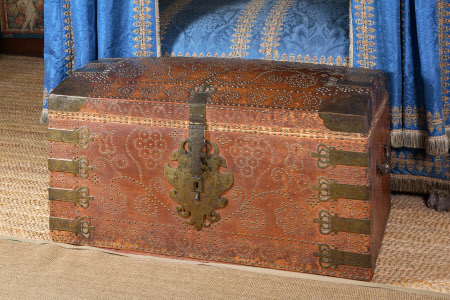Travelling trunk
Category
Furniture
Date
circa 1727
Materials
Leather on pine, brass studs, straps and escutcheons, linen and silk to interior
Measurements
71 x 128 x 71 cm
Place of origin
England
Order this imageCollection
Hardwick Hall, Derbyshire
NT 1127726
Summary
A brass-studded and decorated leather dome-lidded travelling trunk, English, probably London, circa 1727, with a pine carcase lined with linen and with a trellis of red silk tape to the underside of the lid, the domed cover with decorative brass studs forming the date 1727, amid scrolling foliage, tulips and bunches of grapes, similarly decorated to the front and sides, the ends fitted with carry handles, the corners with brass straps with pierced crown terminals, with a decorative hasp and escutcheon. One of three leather trunks [NT 1127784 and NT 1127788] at Hardwick Hall of a type made both for members of the Royal Family, and for courtiers and those holding offices of state in the 17th and 18th centuries. All three were made for Charles Compton (1698 - 1755), brother of the 5th and 6th Earls of Northampton and father of the 7th and 8th Earls, who was Consul (1727 - 1742) and Envoy Extraordinary (1742 - 1745) at Lisbon. They came to Hardwick via the marriage in 1782 of Lady Elizabeth Compton, heiress of the 7th Earl of Northampton, to Lord George Cavendish, 1st Earl of Burlington of the second creation (1754 - 1834). This trunk, dated 1727, marks the first year of Compton's appointment in Lisbon. Recorded as at Hardwick in 1903.
Provenance
By descent until, following the death of Edward William Spencer Cavendish, 10th Duke of Devonshire (1895 - 1950), Hardwick Hall and its contents were accepted by HM Treasury in part payment of death duties and transferred to the National Trust, in 1959.
References
Rowell, Christopher, 'Furniture at Hardwick Hall - II', in David Adshead and David Taylor, Hardwick Hall: A Great Old Castle of Romance (2016), 173 - 5, Figure 176 and 177 Hawkesbury 1903, Lord Hawkesbury, Catalogues of Portraits at Compton Place and at Buxted Park, in Sussex (1903), p. 6
